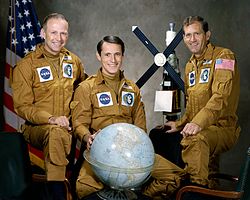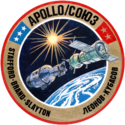Skylab 4
| Skylab 4 | |||
 | |||
| Statistik för uppdraget | |||
|---|---|---|---|
| Uppdrag | Skylab III | ||
| NSSDC-ID | 1973-090A[1] | ||
| Anrop | Skylab 4 | ||
| Varaktighet | 84 dagar, 1 timmar, 15 minuter, 30 sekunder | ||
| Uppskjutning | |||
| Raket | Saturn IB | ||
| Uppskjutningsramp | Kennedy Space Center LC 39B Florida | ||
| Uppskjutning | 16 november 1973, 14:01:23 UTC | ||
| Landning | |||
| Landning | 8 februari 1974, 15:16:53 UTC | ||
| Landningsplats | 31°18′N 119°48′V / 31.300°N 119.800°V | ||
| Omloppsbana | |||
| Varv runt jorden | 1 214 st | ||
| Distans | 55 500 000 km | ||
| Dockning | |||
| Dockning | 16 november 1973, 21:55:00 UTC | ||
| Port | fram | ||
| Ur dockning | 8 februari 1974, 02:33:12 UTC | ||
| Tid dockad | 83 dagar, 4 timmar, 38 minuter, 12 sekunder | ||
| Rymdpromenad | |||
| Antal rymdpromenader | 4 st | ||
| Total tid för rymdpromenad | 22 timmar, 21 minuter | ||
| Besättning | |||
| Besättning | Gerald P. Carr (1) Edward G. Gibson (1) William Pogue (1) | ||
 V-H: Carr, Gibson and Pogue | |||
| Kronologi | |||
| |||
Skylab 4 var den tredje och sista flygningen till den amerikanska rymdstationen Skylab. Farkosten sköts upp med en Saturn IB-raket från Kennedy Space Center LC 39B den 28 juli 1973.
Man dockade med rymdstationen några timmar efter uppskjutningen.
Efter 83 dagar ombord lämnade man rymdstationen den 8 februari 1974. Några timmar senare återinträdde man i jordens atmosfär och landade i Stilla havet.
Besättningen bestod av astronauterna Gerald P. Carr, Edward G. Gibson och William Pogue.
Se även
Källor
Fotnoter
- ^ ”NASA Space Science Data Coordinated Archive” (på engelska). NASA. https://nssdc.gsfc.nasa.gov/nmc/spacecraft/display.action?id=1973-090A. Läst 27 mars 2020.
| |||||||||||||||||||||||
| ||||||||||||||||||||||||||||||||
Media som används på denna webbplats
This is the emblem for the second manned Skylab mission. It will be a mission of up to 56 days. The patch symbolizes the main objectives of the flight. The central figure, adapted from Leonardo da Vinci's Vitruvian Man, illustrates the proportions of the human form and suggests the many studies of man himself to be conducted in the zero-gravity environment of space. This drawing is superimposed on two hemispheres representing the two additional main areas of research - studies of the Sun and the development of techniques for survey of the Earth's resources. The left hemisphere show the Sun as it will be seen in the red light radiated by hydrogen atoms in the solar atmosphere. The right hemisphere is intended to suggest the studies of Earth resources to be conducted on Skylab. Although the patch denotes this mission as Skylab II, it is actually consided to be the Skylab III mission. Image ID: S72-51123
Författare/Upphovsman: Pascal (Flickr user: pasukaru76), Licens: CC0
Vostok spacecraft replica at the Technik Museum Speyer, Germany.
These three men are the prime crewmen for the Skylab 4 mission. Pictured in their flight suits with a globe and a model of the Skylab space station are, left to right, Astronaut Gerald P. Carr, commander; Scientist-Astronaut Edward G. Gibson, science pilot; and Astronaut William R. Pogue, pilot.
This is the emblem for the third manned Skylab mission.
- It will be a mission of up to 56 days. Skylab is an experimental space station consisting of a 100-ton laboratory complex in which medical, scientific and technological experiments will be performed in Earth orbit. The members of the crew will be astronaut Gerald P. Carr, commander; scientist-astronaut Edward G. Gibson, science pilot; and astronaut William R. Pogue, pilot.
- The symbols in the patch refer to the three major areas of investigation proposed in the mission.
- The tree represents man's natural environment and relates directly to the Skylab mission objectives of advancing the study of Earth resources.
- The hydrogen atom, as the basic building block of the universe, represents man's exploration of the physical world, his application of knowledge, and his development of technology. Since the sun is composed primarily of hydrogen, it is appropriate that the symbol refers to the solar physics mission objectives.
- The human silhouette represents mankind and the human capacity to direct technology with a wisdom tempered by regard for his natural environment. It also directly relates to the Skylab medical studies of man himself.
- The rainbow, adopted from the Biblical story of the flood, symbolizes the promise that is offered man. It embraces man and extends to the tree and the hydrogen atom emphasizing man's pivotal role in the conciliation of technology with nature.
Skylab General Mission-Patch
This is the American crew insignia of the joint United States-USSR Apollo-Soyuz Test Project (ASTP). Of circular design, the insignia has a colorful border area, outlined in red, with the names of the five crew members and the words Apollo in English and Soyuz in Russian around an artist's concept of the Apollo and Soyuz spacecraft about to dock in Earth orbit. The bright sun and the blue and white Earth are in the background. The white stars on the blue background represent American astronauts Thomas P. Stafford, commander; Vance D. Brand, command module pilot; and Donald (Deke) K. Slayton, docking module pilot. The dark gold stars on the red background represent Soviet cosmonauts Aleksey A. Leonov, commander, and Valeriy N. Kubasov, engineer.










